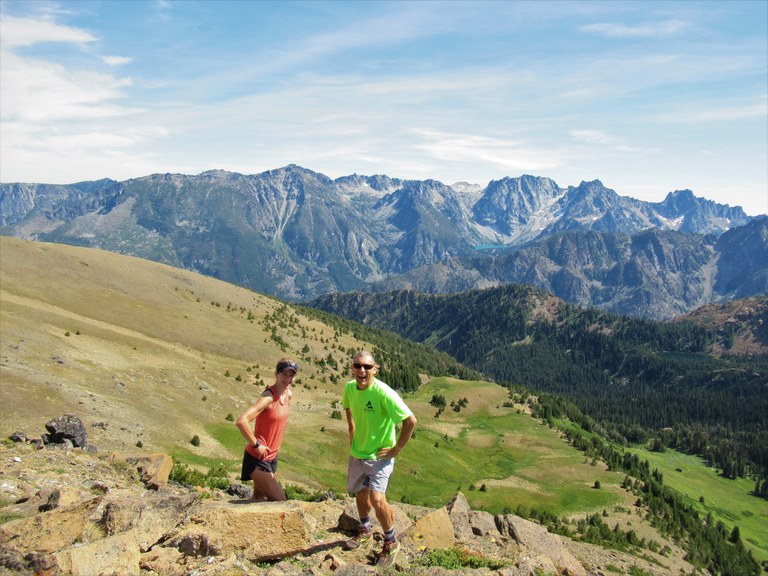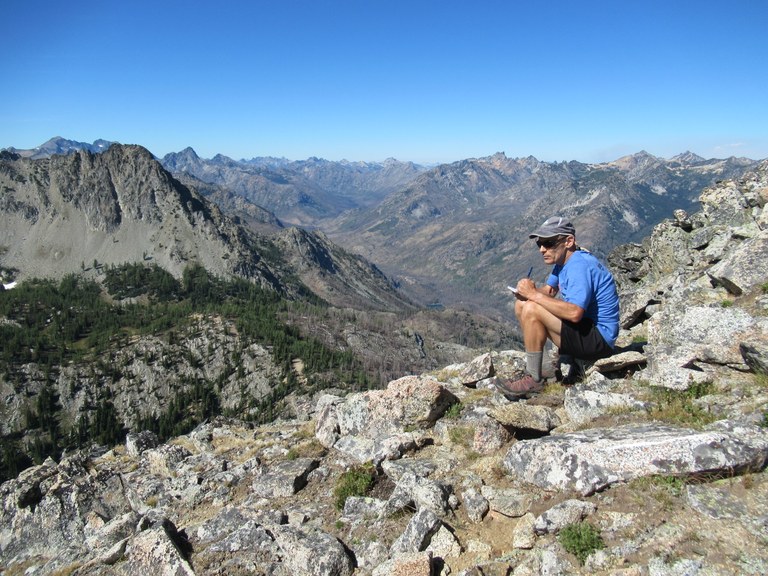 Washington Trails
Association
Washington Trails
Association
Trails for everyone, forever
It starts with really understanding what is important to you when you hit the trail. By Craig Romano
As I approached the mile-high trailhead, sun rapidly fading into the hazy sky, I was glowing. I had just finished 41 miles and 10,000 vertical feet of climbing on the Timberline Trail around Oregon’s Mount Hood — in one day. The fact that I had recently turned 60 and had been diagnosed with an autoimmune disease made this accomplishment all the sweeter. Starting medication that allowed me to move pain free — coupled with a milestone birthday — propelled me to accomplish some big hiking and life goals.
I’ve been tormented my entire life that there’s not enough time to do all the things I want to do. With my insatiable wanderlust and desire to physically challenge myself, I’ve been setting travel and fitness goals — and savoring how they have enhanced my life — for my whole life. At the age of 14, I committed with my best friend to bicycle across the country upon graduating high school. And at 18, I bicycled across the country and around it on an 8-month, 13,000-mile ride through 41 states.
I started running in my 20s to deal with depression and anxiety. I ran my first marathon at 29 and ran Boston for my third. In my late 40s, I decided to put all my hiking and running experience to work. I ran the White River 50-mile Trail Run to celebrate my 50th birthday.

Craig on a 22-mile trail run near Cashmere Mountain. Photo courtesy Craig Romano.
Through the years I’ve been inspired by others’ goals and physical accomplishments. Many folks have offered me guidance, support and encouragement — and now I want to pay it forward. I find that setting hiking and fitness goals affects many other aspects of our lives. Assessing your desires and aspirations, being disciplined and patient to reach them, and looking at the bigger picture is a good way to approach life.
It’s okay to dream big, but be realistic. If your goal is to someday thru hike the Pacific Crest Trail (PCT), but you’re currently only doing short day hikes, you’ll need to do some planning to bring your goal to fruition. But if you don’t start increasing your mileage, working on strength and endurance conditioning, taking overnight trips, researching gear and techniques, saving funds for the trip, and planning for taking the necessary time off from your usual life routines — then your PCT dream will simply remain a dream.
But most importantly, if your goal is to do the PCT, Appalachian Trail, the Camino de Santiago or any other long-distance hike, be sure to do it because you want to do it. This sounds obvious, but plenty of folks take on goals because they feel they need to prove something, because they feel expected to do it or for other, external, motivations. If you’re not passionate and sincere about your goal, you’re more likely to set yourself up for failure. Your goal should be relevant to you and your own situation.

For my 60th birthday celebration, I went back to my home state of New Hampshire and hiked the grueling Presidential Traverse (7 peaks, 19.5 miles, 7,600 vertical feet) in a day! I had worked in the region as a wilderness ranger in my 20s and it was emotional to go back and challenge myself after all of those years. Your goal should be 100 percent centered on you. Folks hit the trail for physical, spiritual and emotional reasons — or to commune with nature, seek self-discovery, partake in a pilgrimage, and much more — but whatever the reason, it should have meaning to you.
Don’t feel like you have to train for a recording-setting, long distance hike — unless you really want to! Goals come in all sizes, and you can be equally satisfied by doing your first solo hike, your first overnight or your longest day hike. Or start trail running, mountain biking, cross-country skiing or some other trail pursuit that you think may lead to self-fulfillment.
And goals don’t have to be grandiose like hiking a national scenic trail in a full sweep. Perhaps a better goal would be to do the PCT in sections. This way, too, you avoid that emotional drop after completing a goal — as you have many years or a lifetime to keep the momentum going. Expand your horizons.
How about hiking some of our other national scenic trails? How about hiking in different national parks or states? A common goal among many marathoners is to join the 50 States Club by running a marathon in each of the states. I pursued something much smaller but equally satisfying trying to be a 39er by running a race in each of Washington’s 39 counties. What a great way to go to places you wouldn’t normally consider.
But no matter your goal, make a plan. Write down what you want to accomplish and when you want to do it. Then outline the formula to make it successful. Research what it takes to be successful achieving it. Surround yourselves with others who are on a similar path. Consider a shared goal with someone else. It’s a great way to stay committed with the added bonus of strengthening a bond. Make goals as a couple or as a family and forever hold shared memories. I just read about a family with two young kids (ages 7 and 9) committed to hiking all of New Hampshire’s 48 highest peaks during the pandemic shutdowns. To their surprise, they finished within 18 months due to the newfound excitement and momentum. Now they have their eyes on doing New England’s 64 highest summits. Completing a worthy hiking goal often leads itself to the next one.

Craig sitting atop Garland Peak in the Entiat Mountains. Photo courtesy Craig Romano.
Don’t let life get in the way of your dreams. Get creative. To stay in shape even when I have a busy schedule, I incorporate my workouts into my routines. I’ll run to an appointment instead of driving, therefore sneaking a workout into my busy schedule. Need motivation to get started? Dedicate your goal. Climb Mount Rainier for a loved one who couldn’t.
Get involved with a cause. WTA’s annual Hike-a-Thon is an excellent way to set a new goal, all while raising money for trails. You’ll be involved with an active community. And you’ll enjoy (and be motivated by) being supported by others and by returning support.
And accept that sometimes life throws you a curve ball or makes too many demands, forcing you to reassess your goals. It’s okay to modify, scale back or completely change course. But just don’t give up. As life progresses and we grow older, accept the changes. I can no longer run the speeds I used to when I was younger. Instead, I now focus on endurance — and even in my 60s I feel I haven’t yet achieved my greatest challenges here.
I have my eyes on someday running a 100K (62-mile) trail race, something I never would have considered in my 20s. The New Year is fast approaching. This is the perfect time to sit down and do some deep reflecting. What have you always wanted to do when it comes to hiking? How can you make that happen? What will it take to get you there? Now begin reaching for your goal as you would when setting out on the trail — one step at a time! Enjoy the journey.
Craig Romano is a hiking guide author; craigromano.com.